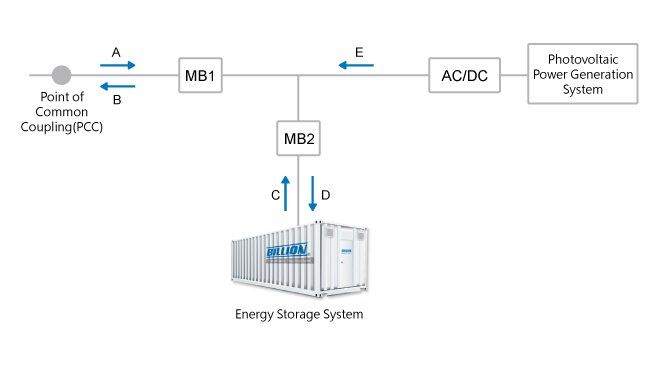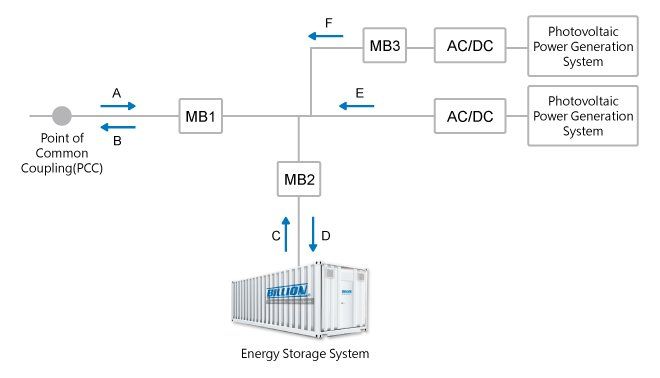The Ministry of Economic Affairs, R.O.C. Solar Energy Plus ESS Installation
In order to maximize the usage rate of feeders and promote the development of solar power generation combined with ESS installation, the Ministry of Economic Affairs announces the amendment of “Directions for 111 years of R.O.C., solar power generation equipment combined with energy storage system bidding and capacity allocation”, which is specified to transfer the day time solar generated energy to night time for soothing night peak electricity supply.
The content of this page is taken from the Ministry of Economic Affairs, R.O.C. – Amendment to the “Key Points of Bidding and Capacity Allocation for Energy Storage Systems Combined with Solar Photovoltaic Power Generation Equipment in 111 years of R.O.C.” – which is announced on September 20, 111 years of R.O.C. then become effective immediately.
Promotion Procedure
1. Verification of Qualification
Verify the qualification of the applicant according to the application materials and required documents submitted by the operators.
2. Sorting of Bidding
Cases that have passed the verification of qualification will be sorted from low to high according to the bidding rate. Those with the lowest bidding rate will be given the priority to obtain capacity. The allocation will be made in sequence on the basis of the current open capacity until the current capacity is met.
3. Follow-Up after Winning a Bid
Announce bidding results > Modify parallel connection verification opinion > Issue the letter of agreement on capacity allocation > Sign or revise the electricity purchase and sale contract
Applicant Qualifications
Application Subject
Solar power generation industry.
Paid-In Capital
More than NT$20 million.
Solar Power
Type 1, above 1MW
Energy Storage
Should be placed outdoors and comply with the safety requirements for ESS installation and Taipower’s regulations on ESS and communication equipment
Bidding Mechanism
Case Planning (Solar and Energy Storage Ratio)
| Energy Storage Power (MW) | Battery Capacity (MWh) | Downgrade Feeder Capacity (MW) | Additional Solar Capacity(MW) | Actual Discharge MWh Calculation |
|---|---|---|---|---|
| 1.0 | ≧2.61 | 1.5 | Without lower limit | If the actual discharge MWh on that day is lower than the daily guaranteed billing electricity MWh (2.61 times of the nominal effective power), unless it is attributable to the applicant or other reasons, the daily guaranteed billing electricity MWh will be used for calculation. |
| Two choose one | Two choose one |
Commitment
- Completion and the grid power connection period:Energy Storage System 15 months, PV 1 years.
- Deposit of bidding:the nominal energy capacity of ESS, NT$1,000/1kWh.
- Significant changes in the content of the plan shall be submitted to the Bureau of Energy for approval:engineering and financial capabilities, system design and setup, and other factors that may affect execution capabilities
- After winning the bidding, sign or revise an electricity purchase and sale contract with TPC:electricity is sold at the electricity rate and battery capacity rate, within a time limit which PV can be sold in FIT.
Selective Principles
- The calculation of the wholesale rate of electricity which is stored then released by ESS, includes the battery capacity rate. The battery capacity rate will serve as the target for bidding.
- If the bidding rate of certain applications is the same, they will be classified in the same sequence. All the bidding rates will be sorted from low to high, then selected sequentially until the assigned capacity of that period is full.
- The highest bidding rate of those selected applications will be considered as the winning rate. All the other applications that have been chosen for that period, will entirely use the winning rate.
Control Mechanism
Inspection and Verification
- From the date of the announcement of the winning bidding results, the Bureau of Energy may inspect or verify at any time.
Non-Refundable Performance Bond
- If ESS is not completed nor connected to the power grid within one year, it will not be refunded. Those who have proper reasons may apply for an extension for a period of less than two months (except for factors that are not attributable to the successful bidder).
- For those whose capacity allocation has been rescinded or revoked, it will not be refunded.
Successful Bidding Rate Deduction
- If the power grid connection is not completed within one year or within the extended period, TPC may deduct the successful bidding rate by 0.5% each month according to the number of overdue months (except for factors that are not attributable to the successful bidder).
Capacity Allocation Rescission or Revocation
- Through inspection or verification, those who didn’t implement the content or commitments in the plan, then didn’t improve within the specified time after notification.
- The qualified documents of renewable energy power generation equipment (such as electric power preparation permission) have been rescinded or revoked.
Solar power station combined with Energy Storage System should correspond with
- Which is already completed and connected to the power grid, those energies which are not yet stored can be wholesaled to TPC, or applied to direct or indirect power supply ; Those energies which are already stored and then released, will be exclusively wholesaled to TPC.
- Which is not yet completed nor connected to the power grid, should obtain the permission of electric power industry preparation before application for each period; After completion and connection to the grid, it should follow the same procedure as mentioned previously.
The successful bidder shall not be held non-attributable due to the delay in the verification of the existing administrative procedures or to the lack of assistance from the government organizations.
Operating Mechanism
Wholesale Purchase Rate and Charge and Discharge Regulations
- The ESS wholesale purchase rate is divided into the electric energy rate (maintaining the revenue generated by the solar power system) and the battery capacity rate (corresponding to the cost of ESS installation).The battery capacity rate is determined by bidding.
- If the amount of power generation exceeds the feeder capacity released by the field, it shall be charged. If it doesn’t exceed the feeder capacity released by the field, it must be charged from 9:00 AM to 2:30 PM every day, and not allowed to be charged during the rest of the time.
- The discharge (including the lifting and lowering load) shall be executed within the designated period of three hours at night as announced by TPC, with the lifting and lowering load rate at 5% per minute.
- If the release-after-storage energy is not discharged within the aforecited period, the payment will be made at the daytime rate.
- If the battery is not charged during the designated period, those charging electric quantities will not be paid.
- Independently complying with TPC's “Principles of renewable energy power generation systems real-time operating data provision and transmission mode”, ESS shall be equipped with remote control and monitoring facilities, and be subject to TPC safety dispatch.
Provisions on Energy Storage System attached to Electricity Purchase and Sale Contract
- The electric energy rate is calculated based on the actual discharge amount; if there are more than 2 types FIT rate of PV sources for storage, the amount will be calculated based on the ratio of charging storage.
- For electric energy that is not stored but released directly, their bulk purchase rate is determined in accordance with the relevant announcements on the applicable bulk purchase rate of renewable energy and its calculation formula.
- The charging and discharging of the energy storage system shall be carried out by Taipower Company in accordance with the dispatch principle. The power (MWh) that is 2.61 times the quantity of nominal effective power (MW) of the energy storage system shall be used as the guaranteed daily billing power. Unless otherwise specified by Taipower, the energy storage system should be charged from 9:00 AM to 2:30 PM every day.
System Impact Analysis
To install a solar energy plus storage system, it is necessary to analyze the system impact under the commitment that the contracted capacity is not exceeded. Considering that some power grids will have power consumptive fluctuations at night, the system impact analysis mainly takes the surrounding state of the power grid at night and the possible impact state of energy storage discharge on the power grid as simulation analysis. TPC will draw up the commitments and implementation procedure for operators so as to facilitate the execution of solar energy plus storage.
Meter Installed Position
Since the system may possess 2 sets of solar energy systems with different rates (expansion + existing), in order to distinguish the price per kilowatt-hour of the electricity entering the feeder, we provide the current planned position of the meter for the new and the existing systems as follows.
New System Meter Installed Position

Existing System Meter Installed Position

Energy Storage Installation Safety
Bureau of Energy referred to “User electrical equipment installation rules”, Chapter VI, Section VII, “Energy storage system”, “Taiwan Power Co., Ltd. energy storage system grid-connected technical guidelines”, and to internal and foreign ESS safety relevant regulations, as verification of qualification for “Energy storage installation safety requirements”. If the follow-up authority publishes relevant regulations for the safety of energy storage installation, it shall be subject to the content of the latest announcement.
The Company
Solutions
886-908-810-876
886-800-585-665
sales@billionwatts.com.tw
7F, No.190, Sec. 2, Zhongxing Rd., Xindian Dist., New Taipei City 231,Taiwan
About Billion Watts
Service items
886-908-810-876
886-800-585-665
sales@billionwatts.com.tw
7F, No.190, Sec. 2, Zhongxing Rd., Xindian Dist., New Taipei City 231,Taiwan
Contact Us
886-908-810-876
886-800-585-665
sales@billionwatts.com.tw
7F, No.190, Sec. 2, Zhongxing Rd., Xindian Dist., New Taipei City 231,Taiwan

